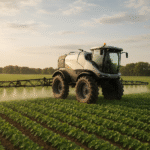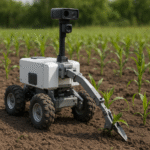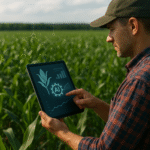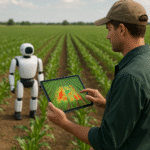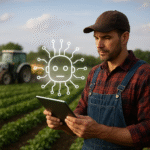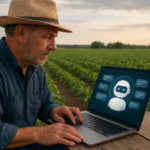Across fertile fields where every pest encounter can make or break a harvest, modern agriculture is turning to cutting-edge technology to maintain healthy crops and boost yields. By harnessing AI-driven solutions, farmers are gaining a competitive edge through enhanced monitoring, rapid response, and precise interventions. This transformation is not simply about eliminating threats—it’s a paradigm shift emphasizing sustainability, resource conservation, and smarter decision pathways for global food security.
Precision Monitoring with AI
The earliest stage of pest management relies on thorough surveillance. Traditional scouting methods are labor-intensive and subject to human error, often leading to delayed or inconsistent responses. Enter drones, satellites, and autonomous ground vehicles equipped with high-resolution cameras and multispectral sensors. These devices continuously capture images across vast acres, feeding a stream of data into machine learning models that can identify pests, diseases, or nutrient deficiencies with remarkable accuracy.
AI platforms process each pixel, comparing current plant health against historical baselines. Algorithms detect subtle changes in leaf coloration, texture, and shape that might signal the onset of an infestation. By employing precision geotagging, alerts can pinpoint the exact coordinates of affected areas, allowing agronomists to focus resources where they matter most. This approach reduces pesticide use, lowering both costs and environmental impact while maintaining high crop standards.
Multispectral Imaging and Early Warning
- Visible light and near-infrared sensors highlight stress indicators invisible to the naked eye.
- Thermal imaging spots areas with unusual temperature patterns linked to insect congregation.
- Machine learning algorithms cross-reference weather, soil moisture, and historical pest data for reliable risk forecasts.
Such integrated systems deliver real-time dashboards, enabling farmers to track pest activity and overall plant health from anywhere in the world. By acting on early warnings, growers avoid reactive measures that can harm beneficial insects and degrade soil structure.
Autonomous Response Systems
Once a pest hotspot is detected, quick action is essential. Autonomous vehicles equipped with AI-driven targeting systems can deploy localized treatments, such as precision spraying or mechanical removal. These smart units interpret geospatial maps, adjust spray nozzles for exact coverage, and apply organic or chemical agents only where needed, minimizing collateral damage.
Robotic Sprayers and Mechanical Weeders
- Robotic sprayers use data analytics to calculate optimal dosages and spray patterns.
- Mechanical weeders leverage computer vision to distinguish between crops and unwanted plants, uprooting weeds without chemicals.
- Solar-powered platforms extend operational hours, increasing field coverage without a carbon footprint.
Through adaptive algorithms, these machines refine their behavior over time. Continuous learning from field performance leads to heightened efficiency, lower energy consumption, and improved pest control outcomes. The result is a harmonized blend of technology and agronomy that keeps farms resilient against evolving threats.
Integrating Data Analytics for Proactive Measures
Data is the new fertilizer. By aggregating environmental variables—soil composition, humidity, temperature—and historical pest occurrences, advanced analytics tools build predictive models for future outbreaks. Farmers receive customized recommendations on planting schedules, crop rotations, and the best moments to apply bio-based interventions.
Cloud-Based Platforms and Collaborative Insights
- Cloud repositories compile anonymized datasets from multiple farms, enhancing model accuracy through broader patterns.
- Interactive dashboards supply growers with actionable insights, complete with risk scores and suggested management plans.
- Mobile applications deliver push notifications for immediate alerts and strategic advisories grounded in decision-making science.
Networked sensors in the field provide continuous feedback loops, updating models in real time. If a sudden rise in insect activity coincides with humidity shifts, the system adapts and refines its guidance. This proactive stance transforms pest control from a reactive chore into a well-coordinated strategy that fosters plant health and resource optimization.
Future Perspectives and Sustainable Impact
As AI platforms evolve, we can anticipate deeper integration with biotechnology, gene editing, and precision irrigation. Collaborative robots may one day engage in multi-modal interventions, blending scouting, data analysis, and targeted action within a single platform. By unifying these capabilities, the industry moves closer to zero-waste agriculture, where every input is monitored, measured, and optimized.
Emphasizing innovation and eco-friendly practices will be key to feeding a growing population without exhausting natural resources. AI-driven pest control exemplifies this ethos, balancing yield maximization with environmental stewardship. Ultimately, the synergy of robotics, autonomous platforms, and advanced analytics charts a roadmap to resilient farms capable of adapting to climate variability and pathogen evolution.
Call to Action for Stakeholders
- Invest in scalable AI technologies that grow with farm operations.
- Foster partnerships between data scientists, agronomists, and equipment manufacturers.
- Promote knowledge sharing across regions to accelerate the adoption of best practices.
By championing these efforts, agricultural communities can secure a future where crop protection is as intelligent as it is sustainable, ensuring bountiful harvests for generations to come.
